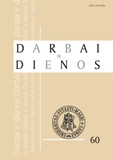Collective Memory: The Choices and the Nature of Representations of the Past in Sąjūdžio Žinios 1988-1989
Collective Memory: The Choices and the Nature of Representations of the Past in Sąjūdžio Žinios 1988-1989
Author(s): Laima VenclauskienėSubject(s): Cultural Essay, Political Essay, Societal Essay
Published by: Vytauto Didžiojo Universitetas
Keywords: Collective memory; Representations of the past; “Blank spots” of history; Sąjūdis; Sąjūdžio žinios; Kolektyvinė atmintis; Praeities reprezentacijos; Baltosios istorijos dėmės; Sąjūdis; „Sąjūdžio žinios“
Summary/Abstract: The article deals with the manifestations of collective memory (representations of the past, where past events are interpreted, conceptualised and used for today’s needs) in Sąjūdžio žinios 1988-1989. As the Soviet regime made great efforts to reinterpret the past and create a programmed and artificial memory by radically confronting the institutionalised and individual memories, Sąjūdis’ goals included filling the “blank spots” of history, primarily targeting the secret protocols of the Ribbentrop-Molotov pact. “The return of history” and “recovered (national) memory” also meant voicing injustices and repressions suffered by the Lithuanians during the Soviet era, such as mass deportations, which, in turn, led to victimhood and “competitive martyrology”, as well as creating the image of the Soviet era as that of constant repressions, darkness and sham. Allusions to the Soviet Union as the (evil) empire (the slaughterhouse of nations) featuring colonial intent and slavery, compared with the Tsarist Empire (the prison of nations) and serfdom, are often used in Sąjūdžio žinios. The phenomenon of reverse-cultural colonisation is observed in the opposition between the periphery (Lithuania) and the Soviet metropolis. The opposition itself is drawn in the form of indifference to the existence of the Lithuanian nation, its exploitation and humiliation. Straipsnyje nagrinėjamos kolektyvinės atminties apraiškos – praeities reprezentacijos, arba praeities įvykio interpretavimas, konceptualizavimas ir vartojimas nūdienos poreikiams, – „Sąjūdžio žiniose“ 1988–1989 m. Sovietinis režimas labai stengėsi iš naujo interpretuoti praeitį ir suformuoti dirbtinę atmintį, kad radikaliai supriešintų institucionalizuotą ir individualiąją atmintis. Todėl vienas iš Sąjūdžio tikslų buvo užpildyti baltąsias istorijos dėmes, pirmiausia paviešinant slaptuosius Molotovo-Ribbentropo pakto protokolus. „Istorijos susigrąžinimas“ ir „atgauta (tautinė) atmintis“ reiškė tautos patirtų kančių (kaip antai, tremties prisiminimų) eksponavimą ir pabrėžimą, kas, savo ruožtu, lėmė viktimizaciją ir „konkuruojančią martirologiją“, taip pat sovietmečio, kaip nuolatinio teroro, priespaudos ir melo, įvaizdžio formavimą. „Sąjūdžio žiniose“ gausu Sovietų Sąjungos kaip (blogio) imperijos (tautų skerdyklos), kuriai būdingi kolonijiniai kėslai ir vergystė, gretinimo su carine imperija (tautų kalėjimu) ir baudžiavine santvarka. Galime pastebėti atvirkštinės kultūrinės kolonizacijos išraiškas kolonijos (Lietuva) ir sovietinės metropolijos opozicijoje. Supriešinimas kaip toks išlaikomas ir nusakomas per svetimumo ir(ar) išnaudotojiškumo santykį, žeminantį imperinį požiūrį ir abejingumą tautos likimui.
Journal: Darbai ir dienos
- Issue Year: 2013
- Issue No: 60
- Page Range: 117-135
- Page Count: 19
- Language: English

